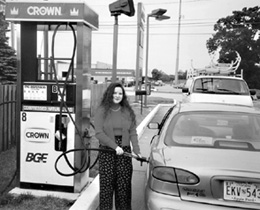 Commentary
CommentaryWhy I Cruise Down The Road on Natural Gas
by Gayle Powell
 Commentary
Commentary
Why I Cruise Down The Road on Natural Gas
by Gayle Powell
As someone committed to the environment, I advocate that all people do whatever we can to protect it. I also believe that we can do more than just participate in the usual role of environmental activism. Environmental efforts can be more than just separating our trash or cleaning up beaches; they can also be as effortless as filling up your gas tank or riding to work with neighbors.
After working with clean air and transportation issues every day at the National Clean Cities Program, a government-industry partnership sponsored by the U.S. Department of Energy to promote the use of alternatives to gasoline and diesel fuel, I decided to purchase a natural gas vehicle myself. When I'm not driving to work in my natural gas vehicle, I am riding in a car pool.
Natural gas is just one of several alternative fuels for transportation available today. Propane, electricity, methanol, ethanol and biodiesel are other alternatives that, like natural gas, provide environmental and economic benefits. These fuels burn cleaner than gasoline or diesel and have the potential to greatly reduce emissions. The vehicles and fuels are in use today, not just as research or demonstration projects.
Take my bi-fuel natural gas Ford Contour. I was able to purchase it at a local Ford dealer, although I did have to special order. My vehicle is covered by the same warranty package as a conventional vehicle. Although the natural gas option is $3,000 to $4,000 more, the fuel cost for natural gas is about 30 percent cheaper than regular unleaded gasoline. So some of the additional cost will be made up in fuel cost savings.
In addition, the state of Maryland offers an income tax credit as an incentive to get more people and businesses to use alternative fuels. For a passenger sedan like mine, the tax credit is $800. Meanwhile, the federal government offers a $2,000 personal or business tax deduction. These incentives, together with the fuel savings, make the cost of buying a natural gas vehicle about the same as buying a conventionally fueled vehicle.
Anne Arundel County has three compressed natural gas, or CNG, refueling sites: one at BWI Airport, one at the Crown station on Veterans Highway in Millersville and one at the Baltimore Gas and Electric site on Dover Street in Glen Burnie. The clean Cities Program is working on a project to install another CNG refueling site in Annapolis.
Statewide, there are about 30 CNG refueling sites. While this is not nearly the number of gasoline refueling sites, it's a start. I also commute to Washington, where there are three natural gas refueling sites within two miles of my office.
Of course, my car also can run on gasoline, so I won't get stuck if there is no refueling site nearby - but I try to run on natural gas as much as possible. I feel better traveling on natural gas because I know I'm making a personal contribution to protecting our environment and the Chesapeake Bay.
My natural gas vehicle is just one way I can express my passion for the environment.
Editor's note: Powell is a Democratic candidate for the Maryland House of Delegates in District 33. As you read this, Maryland's energy efficiency month kicks off with a celebration of the $150,000 state grant enabling Annapolis to build a CNG fueling station.
| Back to Archives |
Volume VI Number 39
October 1-7, 1998
New Bay Times
| Homepage |